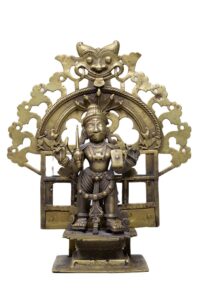
18 Oct GIUSEPPE BERGER “MASTER COLLECTOR”
by Renzo Freschi
I have known Giuseppe Berger since the end of the 1970s, when I had a small shop in Milan’s medieval quarter, selling oriental art and ethnographic objects which I bought in India and South-East Asia. At that time Berger had already spent years putting together some of his numerous collections (cold steel weapons, icons, modern art), only to go on to Indian art after some trips to India, which he visited more than 50 times between 1968 and 2018. Berger is a serial collector, meaning that when he discovers types of objects which intrigue him for their symbolic meaning or the history they contain, he starts buying as many as he can get, even at the cost of adventurous experiences. The over 200 Russian silver saltcellars, the 400 metal icons, the 1206 betel-related objects and many more collections testify to a passion which is anything but bulimic, since each object is studied, classified, and always different from all others – an encyclopedic idea of collecting which reveals a strong desire to be the best.
His “first Indian love” were images of Ganesh, the popular elephant-headed god, of which he owns over 250 pieces. Well-known by all Indian and Italian merchants (the latter nicknamed him “Cicci Ganesh” for years) Berger is famous for his insatiable disposition to buy and his extraordinary ability in driving a hard bargain, almost invariably coming up trumps, and this too is part and parcel of his personality.The first object he bought from me was a bronze plaque of Virabhadra, one of the countless manifestations of Shiva. When Berger learned the story of this powerful and irritable god he was so intrigued that for over 40 years it was the holy grail of his quest and of his trips to India. Those were epic trips, for no sooner had Berger got off the plane than he dressed up, or rather incarnated, into a perfect Indian garbed in white kurta and pajama (a tunic-like shirt and hand-woven loose cotton trousers typical of Gandhi).
His trusted friend and driver Hans Raj would be waiting for him, and together they would scour whole regions where he visited anything from first-rate antique dealers down to the seediest junk yards in search of some of the over 500 plaques or images he progressively managed to collect. His search, almost a devotional act or a personal fixation, once took him to Hampi, one of the most extraordinary archaeological sites not just in India but in the whole world, to see the temple of “his” god. It was in August, when the Indian summer surpasses all concepts of heat and humidity, so our collector was sitting in the shade of the temple having a rest. Suddenly a Brahmin appeared (the Indians’ curiosity for foreigners is uncontrollable) and started to question Berger, and obviously found out the object of his interest. The Brahmin went away only to immediately come back with an ancient stone relief of Virabhadra which he sold to the collector at such a reasonable price that Berger didn’t even have to go into the usual furious bargaining session, delighted for acquiring an image of his beloved god from the very temple dedicated to him .
Through the years his collection became famous and offers came in not just from Indian merchants who came to see him in Milan to propose new acquisitions, but from all over the world. Once he received the brochure of an English antique dealer in which he spotted a superlative 13th-century granite statue about 1.5 m high. Accompanied by his wife he got on the first plane to London and bought the statue. But the story does not end here, for some years later a young Milanese decorator converted to Hinduism accidentally saw the Virabhadra statue in the Berger house garden, where it still stands (photo garden). He asked to meet the owner and he proposed to celebrate a ritual to honor the god. In the presence of a few devotees, along with Berger and his wife, obviously dressed in Indian fashion, Virabhadra thus found an official residence in Milan too.
By now the collection numbers over 500 pieces and is without doubt the most important in the world (photos 4 and 5). To visit it is like entering a huge Virabhadra shrine – a demanding kind of pleasure, considering the number of historical periods, styles and types involved. If you ask for information Giuseppe will delegate Paola, devoted wife but also meticulous cataloguist and historical memory of the collections.In recent years Berger started to part with some of his collections: 52 Russian icons “of the old believers”, small metal images worn around the neck, have been donated to the “Fondazione Peccioli” in the small town of Peccioli near Pisa, and 74 Virabhadra plaques to the Biblioteca Ambrosiana in Milan, one of the most prestigeous Italian picture galleries, where they are displayed in a separate room. But the longest and most arduous operation was the donation of the 1206 pieces of betel-related objects. They were meant to go to India, where a patron had built an extra storey to the local museum for this purpose, but it remained empty due to beaurocracy and customs problems. The entire collection is now in the Museo delle Culture in Rome, waiting to be exhibited in a proper manner as it deserves.May the god of collectors, whatever his name may be, give Giuseppe Berger immortality for his inexhaustible curiosity, for the benefit of art dealers and the glory of museums, for it is important to remember that it has always been the collectors who support the art world. —> 21 October – 19 November 2022
Foto Pietro Notarianni
(Excerpt from the article published on Arts of Asia, Autumn 2022, thanks to the Editor’s copyright policy)










No Comments